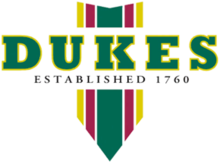British Cricket Balls Ltd
 | |
| Company type | Private |
|---|---|
| Industry | |
| Founded | 1760 |
| Headquarters | London, United Kingdom |
Area served | Worldwide |
Key people | Dilip Jajodia (owner) |
| Products | |
| Website | dukescricket.co.uk |
British Cricket Balls Limited is a British sports equipment and apparel company, specialising in cricket equipment. The company manufactures the Dukes brand of cricket balls used for playing Test cricket in United Kingdom, the West Indies and Ireland.[1] The company was founded in 1760 by the Dukes family.[2] The company is currently owned by Indian businessman Dilip Jajodia, who acquired it in 1987.
History
The Duke family began hand-manufacturing cricket balls as a cottage industry at Redleaf Hill, Penshurst, Kent, England in 1760 and continuing until 1841.[3] Having gained the Royal patent for the cricket balls in 1775, Duke made the first-ever six-seam cricket ball, which was presented to the then Prince of Wales and used in the 1780 English cricket season. In 1851, Dukes triple-sewn ball won a prize medal at the Great Exhibition and a gold medal at the Melbourne International Exhibition in 1880.[4][2]
In 1920, Dukes merged with John Wisden and company a manufacturer of cricket bats.[5][6] In 1999, the company introduced the white ball for that year's Cricket World Cup.[7][8] The company was acquired by Indian businessman Dilip Jajodia in 1987.[9]
Products
The red cricket balls manufactured by the company are used for playing Test cricket in United Kingdom, the West Indies and Ireland. The ball consists of a hand-stitched seam with six rows of threads. The ball retains its shape and characteristics longer compared to the other balls in use and hence provides a good swing. The leather is polished with a synthetic grease with a traditional English Alumtine finish which gives a darker shade to the ball.[10]
See also
References
- ^ "Red or white? Cheers for cricket's swingers". BBC. Retrieved 23 November 2013.
- ^ a b Lennard (1990). The Wisden Book of Cricket Memorabilia. Lennard. p. 238. ISBN 978-1-85291-054-9.
- ^ "'Platypus Gem' Cricket ball and core, 2000: Statement of significance". Powerhouse Museum. Retrieved 23 November 2013.
- ^ "The Cricketing Heritage of Calderdale & Kirklees: "III. Facilities & Equipment", p. 4" (PDF). Archived from the original on 10 July 2012. Retrieved 23 November 2013.
{{cite web}}: CS1 maint: bot: original URL status unknown (link) - ^ "Wisden Timeline". Bloomsbury Publishing Plc. Retrieved 23 November 2013.
- ^ "Words on the Wisden Cricketers' Almanack". Financial Times. Retrieved 23 November 2013.
- ^ "The swinging duke is not all it seems". The Independent. Retrieved 23 November 2013.
- ^ "Why white is the thing for swing". The Guardian. Retrieved 23 November 2013.
- ^ "Meet Dilip Jajodia, check his Kohli, Rohit connection, owns company which is..." DNA. 2 June 2023. Retrieved 7 August 2023.
- ^ "Three of a kind: The different balls used in Test cricket". 14 March 2019.
